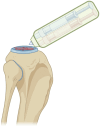Biomaterials for extrusion-based bioprinting and biomedical applications
- PMID: 38974655
- PMCID: PMC11225062
- DOI: 10.3389/fbioe.2024.1393641
Biomaterials for extrusion-based bioprinting and biomedical applications
Abstract
Amongst the range of bioprinting technologies currently available, bioprinting by material extrusion is gaining increasing popularity due to accessibility, low cost, and the absence of energy sources, such as lasers, which may significantly damage the cells. New applications of extrusion-based bioprinting are systematically emerging in the biomedical field in relation to tissue and organ fabrication. Extrusion-based bioprinting presents a series of specific challenges in relation to achievable resolutions, accuracy and speed. Resolution and accuracy in particular are of paramount importance for the realization of microstructures (for example, vascularization) within tissues and organs. Another major theme of research is cell survival and functional preservation, as extruded bioinks have cells subjected to considerable shear stresses as they travel through the extrusion apparatus. Here, an overview of the main available extrusion-based printing technologies and related families of bioprinting materials (bioinks) is provided. The main challenges related to achieving resolution and accuracy whilst assuring cell viability and function are discussed in relation to specific application contexts in the field of tissue and organ fabrication.
Keywords: artificial tissues; biomaterials; biomedical applications; bioprinting; material extrusion.
Copyright © 2024 Rossi, Pescara, Gambelli, Gaggia, Asthana, Perrier, Basta, Moretti, Senin, Rossi, Orlando and Calafiore.
Conflict of interest statement
The authors declare that the research was conducted in the absence of any commercial or financial relationships that could be construed as a potential conflict of interest.
Figures





References
-
- Advanced Solutions. (2015). “BioAssemblyBot 400: more than a bioprinter.” Available at: https://www.advancedsolutions.com/bioassemblybot-400.
Publication types
LinkOut - more resources
Full Text Sources

